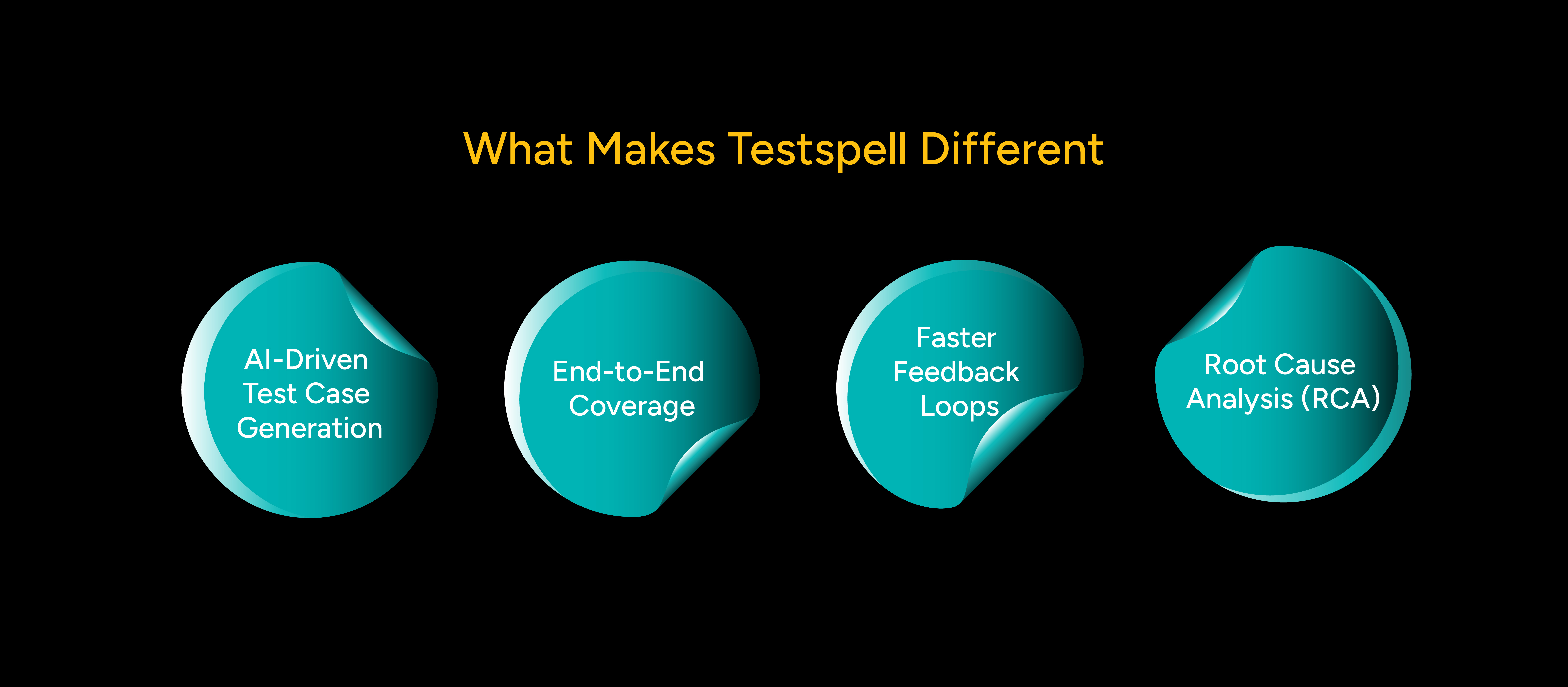December 1, 2025
TL;DR
Most enterprise QA teams rely on multiple disconnected tools for test generation, execution, and reporting, as the result it leads to slower releases, unclear coverage, and constant manual effort.
Testspell solves this by connecting every layer of testing in a single, AI-powered platform. It automatically generates test cases from requirements, runs UI, API, and mobile tests together, and delivers clear insights into why failures happen. For enterprises that move fast, Testspell brings what fragmented QA setups cannot i.e clarity, coverage, and confidence in every release.
The Inefficiencies of Disconnected QA Pipelines
In large organizations, QA often operates as a collection of tools and processes that never fully connect. One team writes test cases manually, another executes them in isolated environments, and a third compiles reports at the end of each sprint. Each step requires manual coordination and context switching.
These disconnected pipelines make it nearly impossible to maintain visibility across the entire testing process. Test data is scattered, test results are delayed, and teams waste valuable time trying to piece everything together. The result is slower delivery, delayed releases, and an overall lack of trust in the QA process.
Disconnected QA isn’t just inefficient, it erodes confidence in release quality and keeps teams reactive instead of forward-moving.
The Enterprise Cost of Disconnection
For enterprise leaders, the impact of fragmented QA pipelines shows up in multiple ways:
- Slower Feedback Loops: Test results arrive too late to help developers fix issues during active sprints.
- Manual Coordination: QA teams spend hours moving data between tools instead of focusing on quality analysis.
- Inconsistent Coverage: When UI, API, and mobile testing are handled separately, critical gaps emerge.
- Reactive Testing: QA becomes a final checkpoint rather than a continuous process embedded in the SDLC.
Even highly automated teams face this problem when their automation tools don’t talk to each other. Without end-to-end visibility, decision-making slows, and the cost of catching defects increases.
Testspell: Built for Connected, Continuous QA
Testspell is AI-powered test automation for modern teams
It replaces fragmented QA workflows with a single connected platform that generates, runs, and analyzes tests in one flow.
Here’s how it transforms QA:
- AI-Driven Test Case Generation: Converts requirements, user stories, or JIRA inputs into comprehensive, ready-to-run test cases
- End-to-End Coverage: Validates every layer of your product, from UI to API to mobile, in one environment
- Faster Feedback Loops: Executes tests across modules, sprints, or full suites with detailed HTML and video reports
- Root Cause Analysis (RCA): Goes beyond test failures to identify the reasons behind them
Testspell does not just automate tasks but also connects every aspect of quality engineering so that testing evolves alongside development instead of trailing behind it.

How Connected Testing Accelerates Enterprise Delivery
When QA functions as one unified system, teams spend less time managing tools and more time improving quality.
- Unified Visibility: Everyone sees the same reports, results, and coverage insights in real time.
- Continuous Quality: By aligning testing with the development process, Testspell ensures that validation starts early and never stops
- Early Defect Detection: Continuous testing identifies bugs before they reach production, reducing cost and rework.
- Simplified Workflows: Teams run and monitor tests in one place, improving efficiency and consistency.
This connected approach aligns QA with enterprise speed enabling teams to deliver faster without compromising reliability or compliance.
Built for the Modern SDLC
Testspell integrates directly into existing workflows, helping teams move faster without changing the way they work.
- Integrations: Compatible with JIRA, Azure DevOps, Postman, and LambdaTest for smooth adoption across organizations
- Enterprise Ready: Equipped with role-based access, project management controls, and scalable LLM integration for large-scale deployments
- Supports Every Role: QA engineers automate tests quickly, developers catch issues earlier, and product owners gain visibility into release readiness
- Aligned With SDLC: Testing evolves along with development, ensuring teams release confidently and continuously
By replacing isolated testing tools with an integrated approach, Testspell helps enterprises deliver with speed and assurance.
The Case for Unified Testing Pipelines
Modern enterprises do not struggle because they lack automation but because their automation is scattered. Disconnected QA pipelines slow innovation and add friction to delivery.
Testspell changes that by connecting every part of the testing process. It gives teams a single source of truth for quality, ensures full coverage across platforms, and delivers insights that help prevent issues instead of reacting to them.
Integrated testing is no longer a nice-to-have. It is how enterprises move faster and deliver safer software at scale.


.png)







.png)